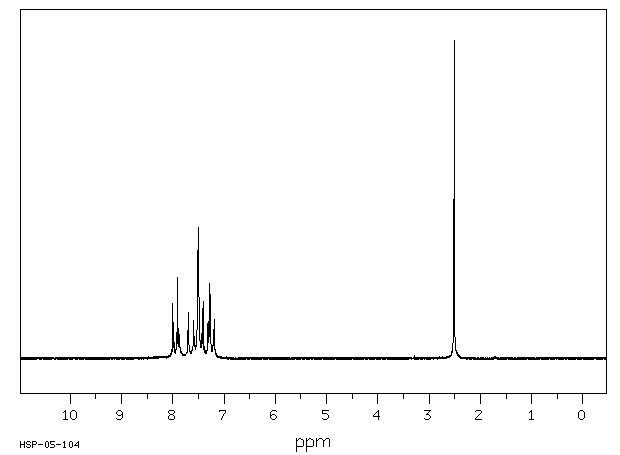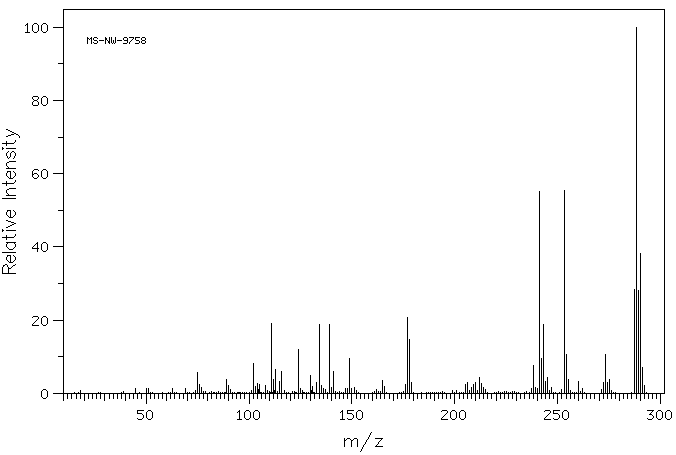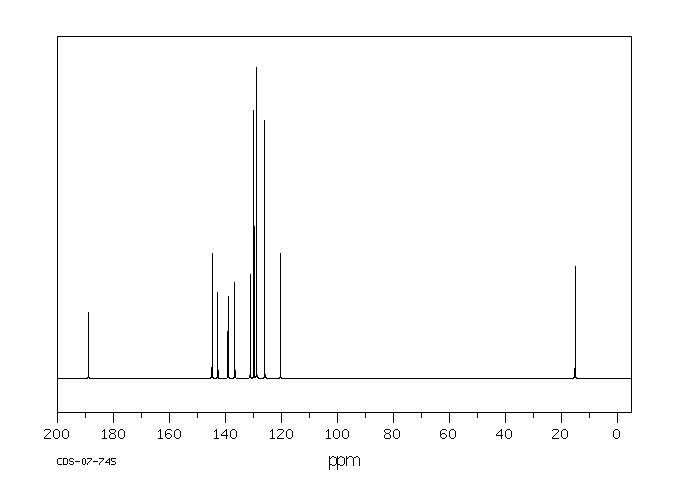(E)-1-(4-chlorophenyl)-3-(4-(methylthio)phenyl)prop-2-en-1-one
分子结构分类
中文名称
——
中文别名
——
英文名称
(E)-1-(4-chlorophenyl)-3-(4-(methylthio)phenyl)prop-2-en-1-one
英文别名
(2E)-1-(4-chlorophenyl)-3-[4-(methylsulfanyl) phenyl]prop-2-en-1-one;trans-4'-Chloro-4-(methylthio)chalcone;(E)-1-(4-chlorophenyl)-3-(4-methylsulfanylphenyl)prop-2-en-1-one
CAS
——
化学式
C16H13ClOS
mdl
——
分子量
288.798
InChiKey
MGQPGLJXWRORLQ-NYYWCZLTSA-N
BEILSTEIN
——
EINECS
——
-
物化性质
-
计算性质
-
ADMET
-
安全信息
-
SDS
-
制备方法与用途
-
上下游信息
-
文献信息
-
表征谱图
-
同类化合物
-
相关功能分类
-
相关结构分类
计算性质
-
辛醇/水分配系数(LogP):4.2
-
重原子数:19
-
可旋转键数:4
-
环数:2.0
-
sp3杂化的碳原子比例:0.06
-
拓扑面积:42.4
-
氢给体数:0
-
氢受体数:2
反应信息
-
作为反应物:描述:(E)-1-(4-chlorophenyl)-3-(4-(methylthio)phenyl)prop-2-en-1-one 、 肼 生成 3-(4-chlorophenyl)-5-(4-methylsulfanylphenyl)-4,5-dihydro-1H-pyrazole参考文献:名称:HES R. VAN; WELLINGA K.; GROSSCURT A. C., J. AGR. AND FOOD. CHEM., 1978, 26, NO 4, 915-918摘要:DOI:
-
作为产物:描述:对氯苯乙酮 、 4-(甲基巯基)苯甲醛 在 sodium hydroxide 作用下, 以 乙醇 、 水 为溶剂, 以82%的产率得到(E)-1-(4-chlorophenyl)-3-(4-(methylthio)phenyl)prop-2-en-1-one参考文献:名称:通过的高度选择性狄尔斯-阿尔德环加成的4,5,6,7- tetrahydrobenzoxazol -2-酮的合成外-恶唑烷-2-酮与查耳酮二烯摘要:本文报道了新颖的4,5,6,7-四氢苯并恶唑-2-酮的合成。它们是通过N-取代的外-恶唑烷-2-酮二烯与查耳酮或双查耳酮作为亲二烯体的高度区域选择性和立体选择性Diels-Alder环加成反应而以中等至良好的产率获得的。DOI:10.1016/j.tetlet.2019.04.027
文献信息
-
CHALCONE DERIVATIVE COMPOUNDS申请人:NIPPON OIL AND FATS COMPANY, LIMITED公开号:EP0328669A1公开(公告)日:1989-08-23Chalcone derivative compounds represented by general formula (I) or (II), wherein R₁ and R₂ each represents a halogen atom, a hydroxy group, an amino group, a dimethylamino group, a nitro group, a cyano group, a phenyl group, an acetyl group, an alkyl group containing 1 to 18 carbon atoms or an alkyloxy group containing 1 to 22 carbon atoms, n₁ and n₂ each represents an integer of 0 to 21, and m₁ and m₂ each represents an integer of 0 to 5.
-
Synthesis, antimycobacterial activity evaluation, and QSAR studies of chalcone derivatives作者:P.M. Sivakumar、S. Prabu Seenivasan、Vanaja Kumar、Mukesh DobleDOI:10.1016/j.bmcl.2006.12.112日期:2007.3In order to develop relatively small molecules as antimycobacterial agents, twenty-five chalcones were synthesized, their activity was evaluated, and quantitative structure-activity relationship (QSAR) was developed. The synthesis was based on the Claisen-Schimdt scheme and the resultant compounds were tested for antitubercular activity by luciferase reporter phage (LRP) assay. Compound C-24 was found to be the most active (similar to 99%) in this series based on the percentage reduction in Relative Light Units at both 50 and 100 mu g/ml levels, followed by compound C-21. Four compounds at the 50 mu g/ml and eight compounds at the 100 mu g/ml showed activity above 90% level. QSAR model was developed between activity and spatial, topological, and ADME descriptors for the 50 mu g/ml data. The statistical measures such as r, r(2), q(2), and F values obtained for the training set were in acceptable range and hence this relationship was used for the test set. The predictive ability of the model is satisfactory (q(2) = 0.56) and it can be used for designing similar group of compounds. (c) 2007 Elsevier Ltd. All rights reserved.
-
‘On water’ synthesis of 2,4-diaryl-2,3-dihydro-1,5-benzothiazepines catalysed by sodium dodecyl sulfate (SDS)作者:Gaurav Sharma、Raj Kumar、Asit K. ChakrabortiDOI:10.1016/j.tetlet.2008.04.146日期:2008.6An efficient synthesis of 1,3-diaryl-2,3-dihydro-1,5-benzothiazepines has been developed by the reaction of various 1,3-diaryl-2-propenones with 2-aminothiophenol in water under neutral conditions catalysed by SDS. Excellent chemoselectivity was observed for substrates possessing halogen atoms or nitro/alkoxy/thioalkyl groups which did not undergo competitive aromatic nucleophilic substitution of the halogen atoms or the nitro group, reduction of the nitro or the a,p-unsaturated carbonyl group, or dealkylation of the alkoxy/thioalkoxy groups. (C) 2008 Elsevier Ltd. All rights reserved.
-
New, High Efficiency Nonlinear Optical Chalcone Co-Crystal and Structure–Property Relationship作者:E. D. D’silva、G. Krishna Podagatlapalli、S. Venugopal Rao、D. Narayana Rao、S. M. DharmaprakashDOI:10.1021/cg2009539日期:2011.12.7In our present study, we attempted to grow the single crystals of (2E)-1-(4-chlorophenyl)-3-[4-(methylsulfanyl)phenyl]prop-2-en-1-one by making use of the slow evaporation solution growth technique at room temperature. But the single crystal X-ray diffraction technique revealed that the grown crystal was a co-crystal with molecular formula C16H13Br0.66Cl0.34OS (4Br4MSP/4Cl4MSP). The presence of functional groups in the molecular structure is confirmed by Fourier transform infrared (FT-IR) spectroscopy. The UV-vis-NIR absorption spectrum shows that this co-crystal has a good transparency window for optical application. Second harmonic generation (SHG) analysis was done to explore nonlinear optical (NLO) characteristics of the material, and the co-crystal was found to have the highest SHG efficiency when compared with all the co-crystals reported in the literature.
-
US3931152A申请人:——公开号:US3931152A公开(公告)日:1976-01-06
表征谱图
-
氢谱1HNMR
-
质谱MS
-
碳谱13CNMR
-
红外IR
-
拉曼Raman
-
峰位数据
-
峰位匹配
-
表征信息
同类化合物
(2Z)-1,3-二苯基-2-丙烯-1-酮,2-丙烯-1-酮,1,3-二苯基-,(2Z)-
龙血素D
龙血素A
龙血素 B
黄色当归醇F
黄色当归醇B
黄腐醇; 黄腐酚
黄腐醇 D; 黄腐酚 D
黄腐酚B
黄腐酚
黄腐酚
黄卡瓦胡椒素 C
高紫柳查尔酮
阿普非农
阿司巴汀
阿伏苯宗
金鸡菊查耳酮
邻肉桂酰苯甲酸
达泊西汀杂质25
豆蔻明
补骨脂色烯查耳酮
补骨脂查耳酮
补骨脂呋喃查耳酮
补骨脂乙素
蜡菊亭; 4,2',4'-三羟基-6'-甲氧基查耳酮
苯酚,4-[3-(2-羟基苯基)-1-苯基丙基]-2-(3-苯基丙基)-
苯磺酰胺,N-[4-[3-(3-羟基苯基)-1-羰基-2-丙烯基]苯基]-
苯磺酰胺,N-[3-[3-(4-羟基-3-甲氧苯基)-1-羰基-2-丙烯基]苯基]-
苯磺酰胺,4-甲氧基-N,N-二甲基-2-(3-羰基-3-苯基-1-丙烯基)-,(E)-
苯磺酰氯化,4,5-二甲氧基-2-(3-羰基-3-苯基-1-丙烯基)-,(E)-
苯磺酰氯,4-甲氧基-3-(3-羰基-3-苯基-1-丙烯基)-,(E)-
苯甲醇,4-甲氧基-a-[2-(4-甲氧苯基)乙烯基]-
苯甲酸-[4-(3-氧代-3-苯基-丙烯基)-苯胺]
苯甲酸,3-[3-(4-溴苯基)-1-羰基-2-丙烯基]-4-羟基-
苯甲酰(2-羟基苯酰)甲烷
苯甲腈,4-(1-羟基-3-羰基-3-苯基丙基)-
苯基[2-(1-萘基)乙烯基]甲酮
苯基-(三苯基-丙-2-炔基)-醚
苯基-(2-苯基-2,3-二氢-苯并噻唑-2-基)-甲酮
苯亚甲基苯乙酮
苯乙酰腈,a-(1-氨基-2-苯基亚乙基)-
苯丙酸,a-苯甲酰-b-羰基-,苯基(苯基亚甲基)酰肼
苯,1-(2,2-二甲基-3-苯基丙基)-2-甲基-
苏木查耳酮
苄桂哌酯
苄基(4-氯-2-(3-氧代-1,3-二苯基丙基)苯基)氨基甲酸酯
芦荟提取物
腈苯唑
胀果甘草宁C
聚磷酸根皮酚










